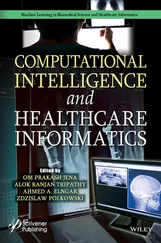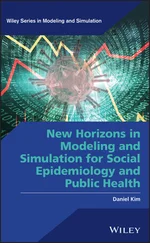Computational Modeling and Simulation Examples in Bioengineering
Здесь есть возможность читать онлайн «Computational Modeling and Simulation Examples in Bioengineering» — ознакомительный отрывок электронной книги совершенно бесплатно, а после прочтения отрывка купить полную версию. В некоторых случаях можно слушать аудио, скачать через торрент в формате fb2 и присутствует краткое содержание. Жанр: unrecognised, на английском языке. Описание произведения, (предисловие) а так же отзывы посетителей доступны на портале библиотеки ЛибКат.
- Название:Computational Modeling and Simulation Examples in Bioengineering
- Автор:
- Жанр:
- Год:неизвестен
- ISBN:нет данных
- Рейтинг книги:3 / 5. Голосов: 1
-
Избранное:Добавить в избранное
- Отзывы:
-
Ваша оценка:
- 60
- 1
- 2
- 3
- 4
- 5
Computational Modeling and Simulation Examples in Bioengineering: краткое содержание, описание и аннотация
Предлагаем к чтению аннотацию, описание, краткое содержание или предисловие (зависит от того, что написал сам автор книги «Computational Modeling and Simulation Examples in Bioengineering»). Если вы не нашли необходимую информацию о книге — напишите в комментариях, мы постараемся отыскать её.
Computational Modeling and Simulation Examples in Bioengineering
Computational Modeling and Simulation Examples in Bioengineering:
Computational Modeling and Simulation Examples in Bioengineering
Computational Modeling and Simulation Examples in Bioengineering — читать онлайн ознакомительный отрывок
Ниже представлен текст книги, разбитый по страницам. Система сохранения места последней прочитанной страницы, позволяет с удобством читать онлайн бесплатно книгу «Computational Modeling and Simulation Examples in Bioengineering», без необходимости каждый раз заново искать на чём Вы остановились. Поставьте закладку, и сможете в любой момент перейти на страницу, на которой закончили чтение.
Интервал:
Закладка:
87 87 Speelman, L., Bosboom, E.M.H., Schurink, G.W.H. et al. (2008). Patient‐specific AAA wall stress analysis: 99‐percentile versus peak stress. Eur. J. Vasc. Endovasc. Surg. 36: 668–676.
88 88 Speelman, L., Bosboom, E.M.H., Schurink, G.W.H., Jacobs, M.J.H.M., and van de Vosse, F.N. (2008). AAA Growth Predicted with Wall Stress. Poster Session Presented at Conference. Mate Poster Award 2008: 13th Annual Poster Contest.
89 89 Speelman, L., Hellenthal, F.A., Pulinx, B. et al. (2010). The influence of wall stress on AAA growth and biomarkers. Eur. J. Vasc. Surg. 39: 410–416.
90 90 Kontopodis, N., Metaxa, E., Papaharilaou, Y. et al. (2013). Changes in geometric configuration and biomechanical parameters of a rapidly growing abdominal aortic aneurysm may provide insight in aneurysms natural history and rupture risk. Theor. Biol. Med. Model. 10: 67.
91 91 Yushkevich, P.A., Piven, J., Hazlett, H.C. et al. (2006). User‐guided 3D active contour segmentation of anatomical structures: significantly improved efficiency and reliability. NeuroImage 31: 1116–1128.
92 92 Anton, R., Chen, C.Y., Hung, M.Y. et al. (2015). Experimental and computational investigation of the patient‐specific abdominal aortic aneurysm pressure field. Comput. Methods Biomech. Biomed. Eng. 18 (9): 981–992. https://doi.org/10.1080/10255842.2013.865024.
93 93 Frauenfelder, T., Lotfey, M., Boehm, T., and Wildermuth, S. (2006). Computational fluid dynamics: hemodynamic changes in abdominal aortic aneurysm after stent‐graft implantation. Cardiovasc. Intervent. Radiol. 29: 613–623.
94 94 Peattie, R.A., Riehle, T.J., and Bluth, E.I. (2004). Pulsatile flow in fusiform models of abdominal aortic aneurysms: flow fields, velocity patterns and flow‐induced wall stresses. J. Biomech. Eng. 126: 438–446.
95 95 Dorfmann, A., Wilson, C., Edgar, E.S., and Peattie, R.A. (2010). Evaluating patient‐specific abdominal aortic aneurysm wall stress based on flow‐induced loading. Biomech. Model. Mechanobiol. 9: 127–139.
96 96 Polzer, S., Gasser, T.C., Markert, B. et al. (2012). Impact of poroelasticity of intraluminal thrombus on wall stress of abdominal aortic aneurysms. Biomed. Eng. Online 11: 62.
97 97 Gasser, T.C., Gorgulu, G., Folkesson, M., and Swedenborg, J. (2008). Failure properties of intraluminal thrombus in abdominal aortic aneurysm under static and pulsating mechanical loads. J. Vasc. Surg. 48: 179–188.
98 98 Gasser, T.C., Auer, M., Labruto, F. et al. (2010). Biomechanical rupture risk assessment of abdominal aortic aneurysms: model complexity versus predictability of finite element simulations. Eur. J. Vasc. Endovasc. Surg. 40: 176–185.
99 99 Wang, D.H.J., Makaroun, M.S., Webster, M.W., and Vorp, D.A. (2002). Effect of intraluminal thrombus on wall stress in patient specific models of abdominal aortic aneurysm. J. Vasc. Surg. I36: 598–604.
100 100 Wang, D.H., Makaroun, M.S., Webster, M.W., and Vorp, D.A. (2001). Mechanical properties and microstructure of intraluminal thrombus from abdominal aortic aneurysm. J. Biomech. Eng. 123: 536–539.
101 101 Ayyalasomayajula, A., Vande Geest, J.P., and Simon, B.R. (2010). Porohyperelastic finite element modeling of abdominal aortic aneurysms. J. Biomech. Eng. 132: 104502.
102 102 Baek, S., Zambrano, B.A., Choi, J., and Lim, C.‐Y. (2014). Growth prediction of abdominal aortic aneurysms and its association of intraluminal thrombus. 11th World Congress on Computational Mechanics (WCCM XI); 5th European Conference on Computational Mechanics (ECCM V); 6th European Conference on Computational Fluid Dynamics (ECFD VI), Barcelona, Spain (20–25 July 2014).
103 103 Zeinali‐Davarani, S. and Baek, S. (2012). Medical image‐based simulation of abdominal aortic aneurysm growth. Mech. Res. Commun. 42: 107–117.
104 104 Vorp, D.A., Lee, P.C., Wang, D.H. et al. (2001). Association of intraluminal thrombus in abdominal aortic aneurysm with local hypoxia and wall weakening. J. Vasc. Surg. 34: 291–299.
105 105 Biasetti, J. (2013). Physics of blood flow in arteries and its relation to intra‐luminal thrombus and atherosclerosis. Doctoral dissertation no. 84. KTH School of Engineering Sciences, Department of Solid Mechanics – vascuMECH, KTH Royal Institute of Technology, SE‐100 44 Stockholm, Sweden.
106 106 Jones, K.C. and Mann, K.G. (1994). A model for the tissue factor pathway to thrombin.II. A mathematical simulation. J. Biol. Chem. 269: 23367–23373.
107 107 Filipovic, N., Milasinovic, D., Zdravkovic, N. et al. (2011). Impact of aortic repair based on flow field computer simulation within the thoracic aorta. Comput. Methods Prog. Biomed. 101 (3): 243–252.
108 108 Filipovic, N., Mijailovic, S., Tsuda, A., and Kojic, M. (2006). An implicit algorithm within the arbitrary Lagrangian–Eulerian formulation for solving incompressible fluid flow with large boundary motions. Comp. Meth. Appl. Mech. Engrg. 195: 6347–6361.
109 109 Filipovic, N., Kojic, M., Ivanovic, M. et al. (2006). MedCFD, Specialized CFD Software for Simulation of Blood Flow Through Arteries. Serbia: University of Kragujevac.
110 110 Perktold, K. and Rappitsch, G. (1995). Computer simulation of local blood flow and vessel mechanics in a compliant carotid artery bifurcation model. J. Biomech. 28: 845–856.
111 111 Figueroa, C.A., Taylor, C.A., Yeh, V. et al. (2009). Effect of curvature on displacement forces acting on aortic endografts: a 3‐dimensional computational analysis. J. Endovasc. Ther. 16: 284–294.
112 112 Figueroa, C.A., Taylor, C.A., Chiou, A.J. et al. (2009). Magnitude and direction of pulsatile displacement forces acting on thoracic aortic endografts. J. Endovasc. Ther. 16: 350–358.
113 113 Filipovic, N., Rosic, M., Tanaskovic, I. et al. (2012). ARTreat project: Three‐dimensional numerical simulation of plaque formation and development in the arteries. IEEE Trans. Inf. Technol. Biomed. 16 (2): 272–278.
114 114 Filipovic, N. and Schima, H. (2011). Numerical simulation of the flow field within the aortic arch during cardiac assist. Artif. Organs 35 (4): 73–83.
115 115 Veljkovic, D., Filipovic, N., and Kojic, M. (2012). The effect of asymmetry and axial prestraining on the amplitude of mechanical stresses in abdominal aortic aneurysm. J. Mech. Med. Biol. 12 (5): 1250089.
116 116 Krsmanovic, D., Koncar, I., Petrovic, D. et al. (2012). Computer modelling of maximal displacement forces in endoluminal thoracic aortic stent graft. Comput. Methods Biomech. Biomed. Eng. 17 (9): 1012–1020.
117 117 Hastie, T., Tibshirani, R., and Friedman, J. (2008). The Elements of Statistical Learning: Data Mining, Inference, and Prediction, Springer Series in Statistics, 2e. New York, NY, USA: Springer.
118 118 Kolachalama, V.B., Bressloff, N.W., and Nair, P.B. (2007). Mining data from hemodynamic simulations via Bayesian emulation. Biomed. Eng. Online 6: 47.
119 119 Martufi, G., DiMartino, E.S., Amon, C.H. et al. (2009). Three‐dimensional geometrical characterization of abdominal aortic aneurysms: image‐based wall thickness distribution. J. Biomech. Eng. 131 (6): 061015.
120 120 Shum, J., Martufi, G., di Martino, E. et al. (2011). Quantitative assessment of abdominal aortic aneurysm geometry. Ann. Biomed. Eng. 39 (1): 277–286.
121 121 Filipovic, N., Ivanovic, M., Krstajic, D., and Kojic, M. (2011). Hemodynamic flow modeling through an abdominal aorta aneurysm using data mining tools. IEEE Trans. Inf. Technol. Biomed. 15 (2): 189–194.
122 122 Pannu, H., Fadulu, V.T., Chang, J. et al. (2005). Mutations in transforming growth factor‐beta receptor type II cause familial thoracic aortic aneurysms and dissections. Circulation 112: 513–520.
123 123 Zhu, L., Vranckx, R., Van Kien, P.K. et al. (2006). Mutations in myosin heavy chain 11 cause a syndrome associating thoracic aortic aneurysm/aortic dissection and patent ductus arteriosus. Nat. Genet. 38: 343–349.
Читать дальшеИнтервал:
Закладка:
Похожие книги на «Computational Modeling and Simulation Examples in Bioengineering»
Представляем Вашему вниманию похожие книги на «Computational Modeling and Simulation Examples in Bioengineering» списком для выбора. Мы отобрали схожую по названию и смыслу литературу в надежде предоставить читателям больше вариантов отыскать новые, интересные, ещё непрочитанные произведения.
Обсуждение, отзывы о книге «Computational Modeling and Simulation Examples in Bioengineering» и просто собственные мнения читателей. Оставьте ваши комментарии, напишите, что Вы думаете о произведении, его смысле или главных героях. Укажите что конкретно понравилось, а что нет, и почему Вы так считаете.












